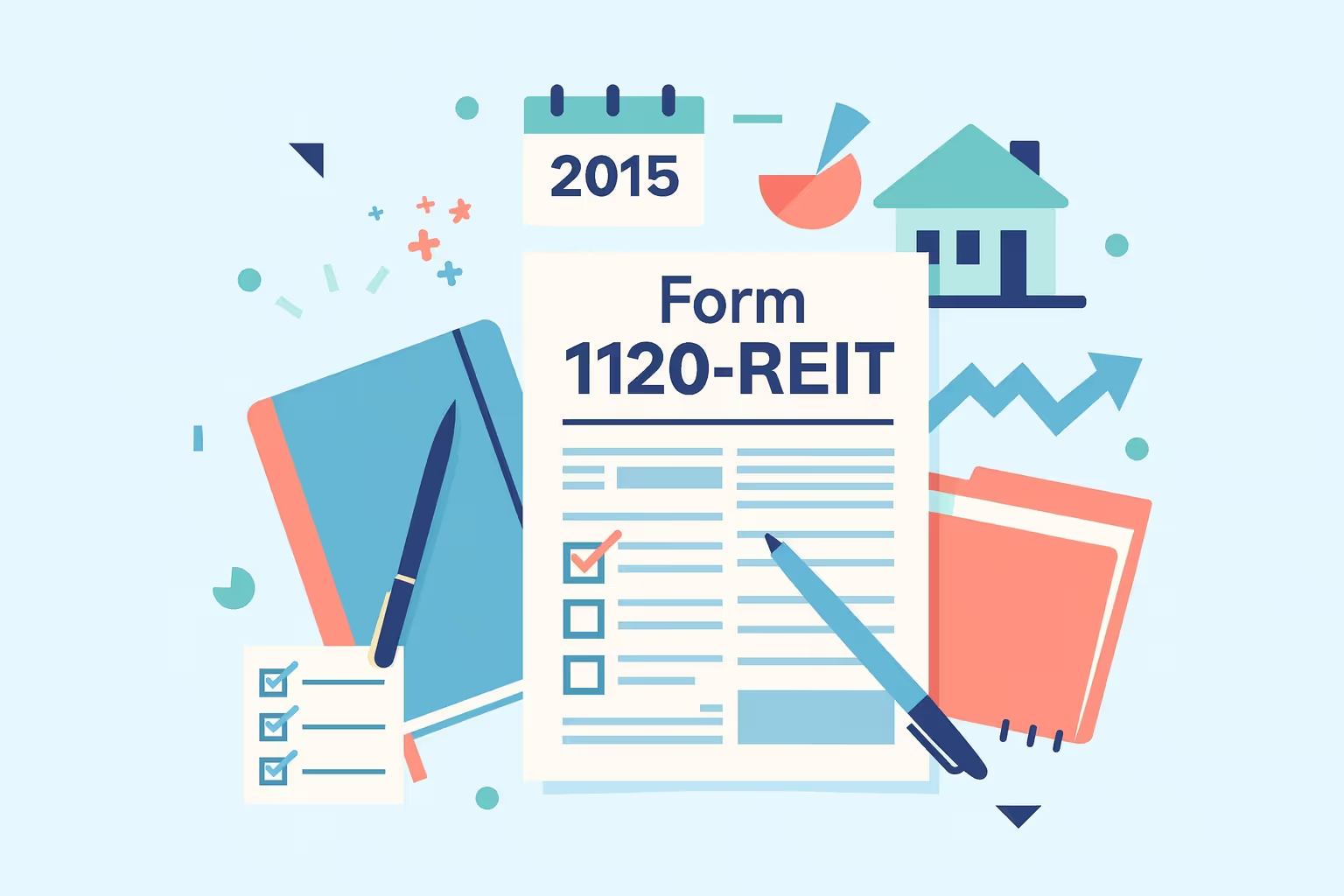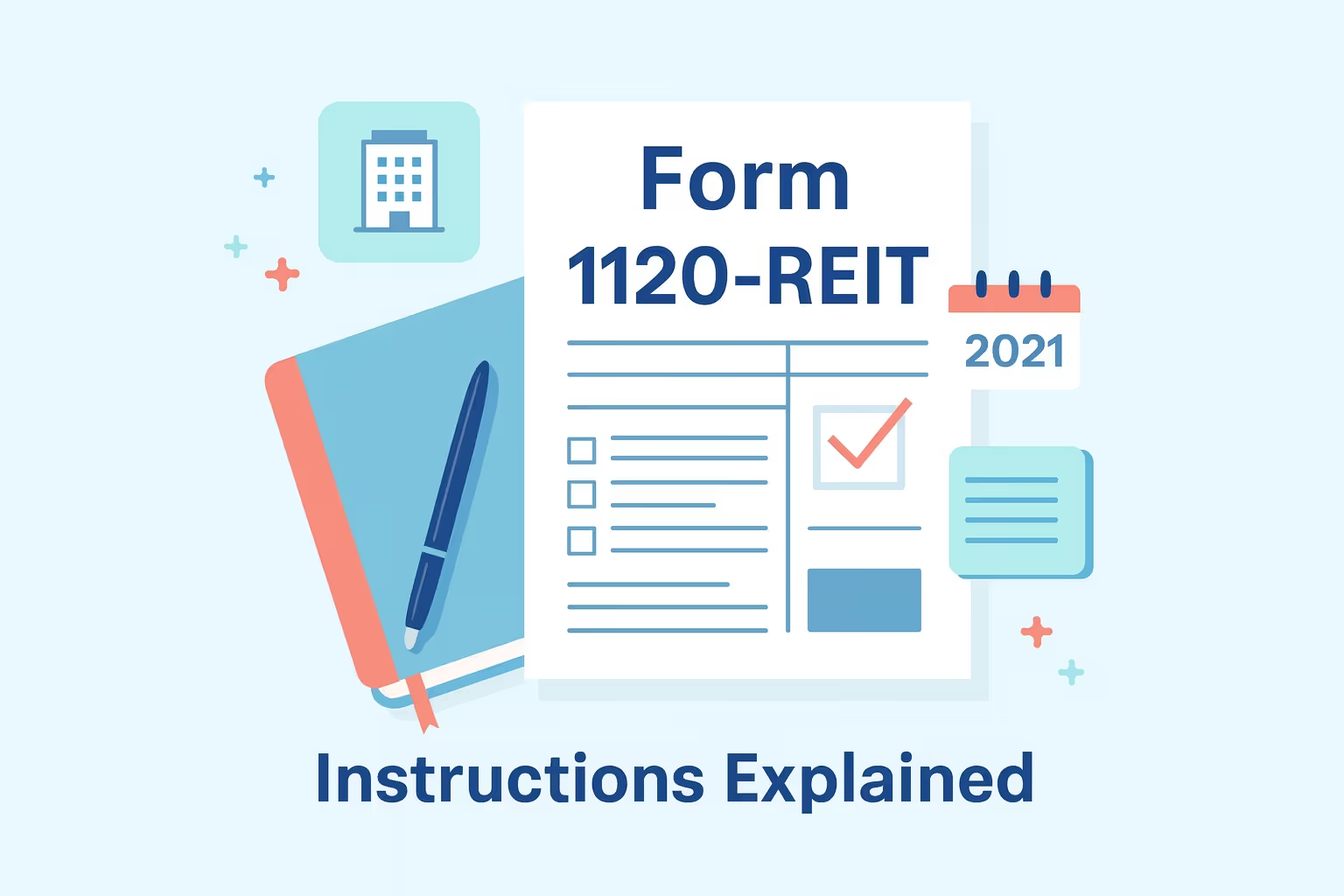
Filing Form 1120-REIT is a crucial requirement for every Real Estate Investment Trust under the Internal Revenue Code. This specialized corporate tax return ensures that REITs report their taxable income correctly, comply with qualification rules, and calculate the deductions available. For the 2019 tax year, several changes have impacted filing, penalties, and compliance requirements.
A Real Estate Investment Trust benefits from unique tax treatment compared to a traditional corporation. REITs pay corporate income taxes only on certain types of income while distributing most of their profits as dividends. This process provides potential benefits for REIT shareholders and ensures that REIT status remains intact. Understanding how to prepare the return correctly is essential for the entity and REIT investors.
This guide covers the 2019 Form 1120-REIT in detail, from eligibility and qualification through filing and payment. It also outlines the tax benefits, obligations, and common mistakes to avoid. Whether dealing with ordinary income, capital gains taxes, or deductions, REIT investors and compliance teams can use this article to comply with filing requirements effectively.
Overview of Form 1120-REIT
Form 1120-REIT is a corporate tax form used by REITs to report REIT taxable income, deductions, distributions, and income tax liability. It also ensures accurate reporting of REIT dividends and special REIT-related taxes. Unlike traditional corporations, REITs must demonstrate that most of their earnings are distributed to shareholders as dividends.
Who Must File Form 1120-REIT?
- Taxable income reporting: This ensures accurate reporting of the REIT’s earnings, including ordinary and capital gains, which helps calculate the correct income tax liability.
- Dividend deductions: This provision allows REITs to deduct dividends paid to shareholders, reducing corporate income taxes significantly while maintaining compliance with federal tax treatment rules.
- Compliance with tests: This confirms the REIT meets income, asset, and distribution tests outlined in the Internal Revenue Code, ensuring qualification and protecting REIT status.
Key Purposes of the Return
- Taxable income reporting: The return ensures accurate reporting of the REIT’s taxable income, including ordinary and capital gains, to establish the correct corporate tax liability.
- Dividend deductions: The return allows REITs to deduct dividends paid to shareholders, which reduces corporate income taxes and supports compliance with REIT distribution requirements.
- Compliance with tests: The return confirms that the REIT satisfies income, asset, and distribution tests under the Internal Revenue Code, ensuring continued qualification for REIT status.
Key Updates for 2019 Tax Year
Several changes affect REITs' filing for the tax year 2019. These updates involve penalties, charitable contributions, and disaster relief provisions. REIT investors and shareholders should take note of these revisions.
Updated Penalties
- Increased failure-to-file penalties: If a REIT tax return is over 60 days late, penalties increase to the lesser of unpaid income tax or $435.
- Ongoing late payment charges: Penalties apply monthly if a REIT does not pay corporate income taxes when due.
- Additional IRS scrutiny: The Internal Revenue Service may apply further penalties for incomplete, incorrect, or late REIT filings.
Disaster Relief and Credits
- Charitable contribution relief: Contributions for qualified disaster relief are not subject to the 10% limit on deductions, increasing REIT tax benefits.
- Employee retention credits: REITs affected by disasters can claim credits using Form 5884-A, reducing income tax liability and easing financial burdens.
Continuing Requirements
- E-file thresholds remain: Large REITs must e-file, while smaller ones may still choose paper filing.
- Electronic payment enforcement: All federal tax deposits must be made through EFTPS.
- REIT qualification unchanged: The REIT must meet the gross income and asset tests to keep REIT status.
Pre-Filing Preparation 1120-REIT
REIT Investors should prepare essential information and organize supporting documentation before filing Form 1120-REIT. Proper preparation ensures accurate reporting and reduces the risk of penalties.
Organizational Information
- REIT identification details: Filers must provide the legal name, employer identification number, principal address, and the date the REIT election officially became effective.
- Entity structure: Entities must confirm whether they operate as equity REITs or mortgage REITs, following definitions established in the Internal Revenue Code.
- Total assets reporting: Corporations should disclose the total value of real estate assets and additional holdings at year-end to ensure complete and accurate reporting compliance.
Financial Records
- Income statements: REITs must gather rental income data from apartment complexes, commercial properties, and mortgage interest earned during the relevant taxable year.
- Expense tracking: Filers are expected to track wages, depreciation, rent, repairs, and other deductible expenses for maintaining and managing real estate assets.
- Distribution records: Entities must maintain accurate records of shareholder distributions, dividend payments, and cash transactions made throughout the tax reporting period.
Forms and Schedules
- Schedule D and Form 4797: These forms report capital gains and losses from property or investments that were eventually sold during the tax year.
- Schedules M-1 and M-2: Corporations use these schedules to reconcile taxable income and retained earnings with financial statements, ensuring accuracy between book and tax records.
- Additional forms: Filers may need to submit Form 5472 for foreign-owned corporations, Form 2438 for capital gains, and Form 8612 for excise tax reporting.
Step-by-Step Completion of Form 1120-REIT
Filing Form 1120-REIT requires attention to detail at each step. Each section of the form deals with specific aspects of REIT taxation, income, and deductions.
Step 1: Complete Header Information
Provide the REIT’s legal name, employer identification number, business address, date the REIT election was established, and total assets. Identify the REIT as an equity or a mortgage REIT, and include the principal business activity code. Accuracy here ensures the IRS can process the tax return without delays or penalties.
Step 2: Report Income
Enter gross income across several categories. These include dividends received, interest earned on mortgage investments, rental income from apartment complexes and properties, and any capital gains. All taxable income must be disclosed accurately. Supporting documentation, such as property records and account statements, should be retained for verification by the IRS.
Step 3: Deduct Expenses
Itemized deductions include wages, depreciation on real estate assets, repairs, rent, and interest. Advertising, taxes, and maintenance also fall under allowable deductions. Proper reporting ensures REITs reduce their taxable income fairly and in compliance with the Internal Revenue Code. Supporting forms may be required to document these expenses.
Step 4: Apply Special Deductions
The deduction for REIT dividends significantly reduces corporate income. This includes distributions to REIT shareholders and consent or deficiency dividends where applicable. The dividends paid deduction directly lowers income tax liability, ensuring the REIT retains its special tax treatment. Accurate dividend records are critical for supporting these deductions.
Step 5: Calculate Special Taxes
Special sections apply to foreclosure property income, failures in income qualification tests, and prohibited transactions. REITs may be subject to capital gains, ordinary income taxes, or a 100% prohibited transaction tax. Each tax must be calculated and included. These sections ensure that REITs comply with the Internal Revenue Code while maintaining their REIT status.
Distributions and REIT Qualification
A Real Estate Investment Trust must meet distribution and qualification requirements to keep its REIT status, including income tests, asset tests, and the distribution of the REIT’s earnings to shareholders. Understanding these thresholds ensures compliance with the Internal Revenue Code and preserves tax benefits for REIT investors.
The 90% Distribution Test
- Dividend requirement: REITs must distribute at least 90% of their taxable income as dividends to shareholders, with the entity's income tax liability.
- Payment deadline: Distributions must generally be paid by the tax return due date, ensuring deductions remain valid and REIT status continues under federal taxation rules.
- Deduction benefit: Meeting the 90% requirement allows REITs to deduct dividends paid, lower corporate income taxes, and protect the trust’s favorable tax treatment overall.
Distribution Timing Rules
- Year-end distributions: Dividends declared in October, November, or December and paid by January 31 qualify as distributions for the previous year’s taxable income.
- Deficiency dividends: REITs may cure shortfalls by paying deficiency dividends, which must be reported on Form 976 and approved to secure deduction benefits.
- Consent dividends: Shareholders can consent to treat retained earnings as dividends, ensuring the deduction is preserved even without immediate cash distributions being issued.
REIT Qualification Tests
- Gross income test: At least 95% of gross income must come from qualifying sources such as rents, mortgage interest, dividends, or capital gains.
- Asset diversification test: At least 75% of total assets must be real estate assets, cash, or government securities, ensuring the REIT maintains compliance with qualification rules.
- Ownership requirements: To maintain REIT status, REITs must not be closely held and must have at least one hundred shareholders beginning in their second tax year.
Filing Methods and Deadlines
REITs filing Form 1120-REIT for 2019 must consider electronic filing rules, paper filing exceptions, and payment deadlines. Filing on time and using the proper method prevents penalties and preserves REIT qualification.
Electronic Filing Requirements
- Large REITs: Entities with $10 million or more in assets and at least 250 returns annually must use IRS-approved systems exclusively.
- Smaller REITs: Entities below the mandatory e-file threshold may still file on paper, though electronic filing is faster and offers immediate IRS confirmation.
- Attachments: All schedules, statements, and additional forms must be included in electronic submissions to ensure IRS acceptance and to prevent unnecessary return rejections.
Paper Filing Addresses
- East region REITs: Entities in eastern states file with Kansas City if assets are under $10 million, while larger REITs must file in Ogden, Utah.
- West region REITs: All western states file in Ogden, Utah, regardless of their total asset size or filing complexity.
- Foreign filers: International REITs and those in U.S. territories must submit returns to Ogden, Utah, using the IRS address for foreign entities.
Filing Deadlines
- Standard due date: Returns are due on the 15th day of the fourth month after the tax year ends, following federal corporate tax filing rules.
- Calendar year REITs: For 2019 calendar-year REITs, the due date was April 15, 2020, unless a valid filing extension request was submitted.
- Extensions: Form 7004 provides an automatic six-month extension, but REITs must still pay corporate income taxes by the original deadline to avoid penalties.
Payments and EFTPS
REITs must electronically pay corporate income taxes, estimated tax, and other required deposits. The Electronic Federal Tax Payment System (EFTPS) ensures compliance and prevents penalties for late payments.
EFTPS Requirements
- Mandatory use: All REITs must use EFTPS for tax return balances, estimated taxes, and employment deposits, ensuring timely electronic compliance nationwide.
- Submission timing: Payments must be submitted by 8 p.m. Eastern Time the business day before due dates to ensure proper federal tax crediting.
- Confirmation process: REITs must retain EFTPS confirmation numbers for each transaction, document compliance, and provide audit-ready evidence of proper tax payment.
Same-Day Wire Payments
- Backup option: REITs missing EFTPS deadlines may use same-day wire transfers, though financial institutions may apply fees that increase overall compliance costs.
- Keep confirmations: Account records and wire confirmations must be retained to prove timely payments and to satisfy IRS verification.
- Urgent compliance: Same-day wires are generally reserved for emergencies, ensuring last-minute REIT tax payments satisfy filing and compliance obligations.
Required Schedules and Attachments
Form 1120-REIT requires multiple schedules and supporting documents. These schedules calculate deductions, disclose corporate details, and report REIT’s earnings. Missing attachments can result in penalties or the IRS rejecting the tax return.
Core Schedules
- Schedule A: This schedule calculates deductions for dividends paid, including consent and deficiency dividends, and reduces taxable income significantly when REITs distribute earnings properly to shareholders.
- Schedule J: Corporations use this schedule to compute overall tax liability by applying standard tax rates, capital gains taxes, and penalties against REIT taxable income.
- Schedule K: Filers disclose general corporate information here, including accounting methods, ownership records, and foreign shareholder details, ensuring complete compliance with IRS disclosure requirements.
- Schedule L: This schedule presents detailed balance sheets per books, documenting beginning and year-end values of real estate assets, liabilities, earnings, and retained capital.
Conditional Schedules
- Schedule D: Entities report capital gains and losses on real estate properties or REIT shares sold during the tax year, supported by detailed Form 8949 attachments.
- Schedule M-1: This schedule reconciles corporate book income with taxable income, ensuring consistency between IRS reporting and official company financial statements.
- Schedule M-2: Filers track retained earnings changes here, documenting profits, dividends, and distributions to provide transparency into REIT’s annual earnings activities and corporate distributions.
Additional Forms
- Form 2438: REITs use this form to report undistributed capital gains, ensuring income taxes are paid on amounts not distributed to shareholders.
- Form 8612: This form calculates excise taxes on undistributed income when REITs fail to meet the required distribution levels for taxable income compliance.
- Form 5472: Filers with 25% or more foreign ownership submit this form to disclose transactions with foreign entities and confirm compliance with legal requirements.
- Form 8865: This form is required for REITs engaging with foreign partnerships, disclosing investments abroad while maintaining compliance with U.S. international tax laws.
Common Errors and How to Avoid Them
Even with clear IRS guidance, many REITs face penalties due to preventable mistakes. Recognizing these errors helps entities prepare more accurate returns and safeguard REIT status.
Distribution Errors
- Miscalculating dividends: Some REITs understate required dividend payments, disqualifying deductions and increasing income tax liability for the entity and REIT shareholders.
- Incorrect timing: Distributions not aligned with IRS deadlines fail to qualify for deductions, exposing the REIT to penalties and additional corporate income taxes.
Classification Mistakes
- Asset misclassification: Mislabeling assets undermines REIT qualification tests, resulting in risks that permanently cause REITs to lose special tax treatment.
- Income misreporting: Incorrectly classifying ordinary income versus capital gains changes tax rates, impacting deductions, taxable income, and total tax liabilities significantly.
Filing Oversights
- Missing schedules: Failure to include required schedules, such as Schedule A or D, leads to incomplete filings, rejected returns, and costly IRS penalties.
- Improper signatures: Returns lacking authorized corporate officer signatures or required preparer details are invalid, delaying acceptance and increasing exposure to penalties.
Special Situations
Some REITs face circumstances requiring different filing approaches, such as dormant years or operations with taxable subsidiaries. These require specific attention to preserve REIT status.
Dormant Year Filings
- Filing obligations remain: REITs with minimal income or no distributions must file Form 1120-REIT annually until their status is formally revoked.
- Simplified reporting: Dormant REITs may report limited income, such as interest or small rents, but still must show compliance with qualification rules.
- Maintaining records: Entities should retain quarterly calculations of income and assets, even during dormant years, to prove continuous compliance with REIT qualification tests.
Taxable REIT Subsidiaries
- Purpose of TRS: Taxable REIT subsidiaries allow REITs to conduct business outside qualifying income tests without jeopardizing REIT status.
- Legal requirements: All transactions between a REIT and its TRS must be conducted at arm’s length, following the Exchange Commission rules and IRS regulations.
- Limitations imposed: TRS assets cannot exceed 20% of the REIT’s assets, preventing over-reliance and protecting qualification tests under federal tax rules.
First-Time Filers
Filing Form 1120-REIT for the first time requires special care. Entities making their initial REIT election must prove compliance with both organizational and qualification rules.
Making the Election
- Election method: The election is made simply by filing Form 1120-REIT and computing taxable income as a REIT for that tax year.
- Effective period: Once made, the REIT election applies for the full tax year and generally cannot be revoked for at least five years.
Year-One Priorities
- Relaxed ownership tests: The 100-shareholder and closely held tests apply beginning in year two, allowing flexibility during the initial qualification year.
- Asset and income rules: REITs must meet gross income and asset diversification tests immediately, ensuring investments and real estate assets comply with IRS rules.
- Recordkeeping systems: Establishing clear records for dividends, shareholder distributions, and taxable income ensures smooth filing in year one and subsequent years.
Frequently Asked Questions
How do I determine if electronic filing is mandatory for my REIT?
For REITs with at least $10 million in assets and 250 or more returns annually, electronic filing is required. Smaller entities may still e-file voluntarily, which provides faster processing and official IRS confirmation. Paper filing remains acceptable only for those under the threshold or with returns requiring attachments unsupported by electronic filing.
What penalties apply if my 2019 return is filed over 60 days late?
If a REIT’s return is filed more than 60 days late, the penalty is less than the unpaid income tax or $435. Standard monthly failure-to-file penalties may also apply. Timely tax payment does not remove the filing penalty, but submitting the return quickly can reduce exposure to additional interest and penalties.
Can dividends paid in January be treated as paid in the prior tax year?
Yes, dividends declared in October, November, or December and paid by January 31 are considered to have been paid on December 31 rather than January 31. Even when shareholder distributions take place immediately after the end of the tax year, the distribution test, the preservation of dividend deductions, and the maintenance of REIT status are all maintained.
How is income from foreclosure property reported and taxed on Form 1120-REIT?
Income from foreclosure property is reported in Part II of Form 1120-REIT and taxed at a flat 21%. Both rental and sale income from such property are included. This separate taxation ensures foreclosure property earnings are correctly reported while the REIT continues to meet its standard income and asset qualification requirements under federal law.
Which forms are required if my REIT has significant foreign ownership?
A REIT with at least 25% foreign ownership must file Form 5472 disclosing related-party transactions and ownership information. Additional forms may apply if the REIT invests through foreign partnerships or subsidiaries. Full disclosure ensures compliance with the Internal Revenue Code and prevents penalties that apply when international activities are not properly reported to the IRS.



































